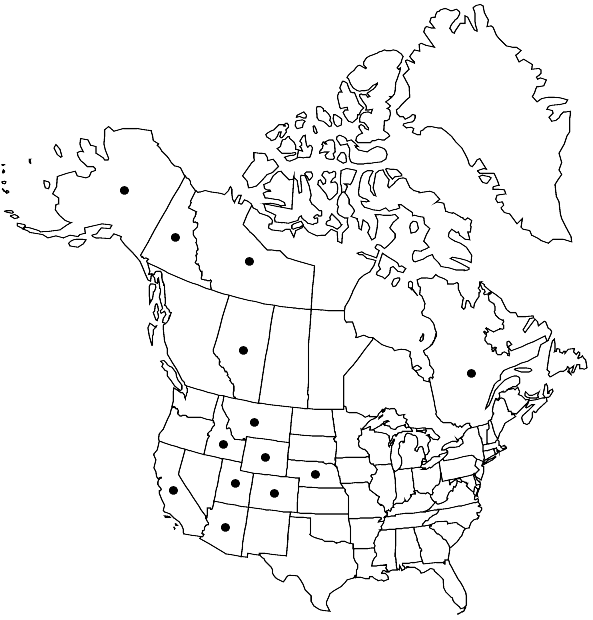Tortella alpicola
Ann. Bryol. 3: 54. 1929,.
Plants light or dark and vivid or clear green distally, pale buff-brown proximally with glistening white leaf-bases, elongate, not rosulate. Stems thin, slender, 0.5–1 (–1.5) cm, branches few to several, central strand present and conspicuous, not tomentose except in perichaetiate plants. Stem-leaves fragile, closely to loosely aggregated, uniform in size, apices in sterile plants (except the youngest) usually fallen, incurved-circinate and weakly contorted when dry, erect-spreading, occasionally patent when moist, gradually longlanceolate, 1.5–2 mm; base undifferentiated or somewhat broader than the limb, elliptical; margins of some leaves weakly undulate, constricted, lobed in scallop-shapes in several places distally, erect to incurved; apex narrowly acuminate, occasionally sharply contracted into a subula in the apical 1/3, this a papillose cylinder about the size of the costa, composed of a series of barrel-shaped segments disarticulating at constrictions, intact subula and tip of propaguloid apex with an apiculus of several cells, this usually dentate and tipped by one or two, elongate, sharply pointed clear cells, in sterile plants leaf apices caducous along zones of weakness; costa short-excurrent, in leaves of fertile plants adaxial surface covered distally by an epidermis of quadrate, papillose laminal cells, back of the costa smooth throughout—in leaves of fragile sterile plants abaxial costa surface smooth only proximally apical subula, densely papillose on both adaxial and abaxial surfaces in the distal subulate region, in cross-section cells weakly differentiated and frequently rather chaotic, adaxial epidermis always present, adaxial stereid cells often disappearing in the distal region of the leaf, proximal laminal cells abruptly differentiated from distal cells, pale white-hyaline and transparent; distal laminal cells relatively large, 10–14 µm wide, lamina 1-stratose but apparently 2-stratose at juncture of lamina and costa, especially along the distal costa in propaguloid leaves of sterile plants; marginal cells undifferentiated, papillose-crenulate throughout. Specialized asexual reproduction in two modes, a general fragility of the leaf lamina as well as smaller, soft, multistratose, propaguloid deciduous leaf apices articulated by regular constrictions, falling early in units of approximately uniform length. Sexual condition apparently dioicous; perigonia not seen; perichaetiate stems tomentose, perichaetia terminal on successive perichaetial innovations; outer perichaetial leaves differentiated, especially evident when dry, longer than the cauline leaves, longlanceolate to linear-lanceolate, fragile, tipped with long, rigid, subulate, smooth awns; rising beyond the contorted stem-leaves when dry, not propaguloid, unbordered. Sporophytes unknown.
Habitat: Shaded or exposed, wet or dry rocks, crevices and ledges of granite, quartzite, schist, sandstone and calcareous outcrops on cliffs and in canyons, cracks in a limestone gully, cavern, wet, mesic tundra, wet log, dry limestone cliff face
Elevation: low to high elevations (20-3300 m)
Distribution

Alta., N.W.T., Que., Yukon, Alaska, Ariz., Calif., Colo., Idaho, Mont., Nebr., Utah, Wyo., South America (Colombia), Asia (India), Pacific Islands (Hawaii), Antarctica (Alexandra Island)
Discussion
Tortella alpicola is associated with a western corridor of both montane and valley habitats, including the western Great Plains, extending in an arc from Arizona to Ellesmere Island. It is the smallest of the North American Tortellae. The plants are noted by their small size, absence of tomentum on typical (sterile) stems, broken tips on most of the leaves, vividly shining white leaf bases on the stem in contrast with the deep or bright green of the limb, and large leaf cells (to 14 µm wide). Small fertile plants of T. tortuosa and T. inclinata have a similar aspect; these also have stiff, awned perichaetial leaves distinct from the cauline leaves. The large leaf cells and presence of a distinct stem central strand in T. alpicola will differentiate ambiguous specimens from similarly small stems of T. tortuosa and T. fragilis. The costal anatomy of leaves of T. alpicola shows two sets of characteristics, one for sterile plants and one for fertile (perichaetiate). In sterile plants, the costal layers (epidermis, stereids and guide cells) are weakly differentiated and in many cases, not differentiated at all; the costa is undifferentiated in the proximal part of the leaf where the laminae are fully extended and 1-stratose. The laminae are never fully 2-stratose but occasionally exhibit 2-stratose patches. In sterile plants, the epidermal and guide cell layers may be chlorophyllose and there are papillae on the abaxial surface of the costa. In T. fragilis, the costal cells become undifferentiated in the nonlaminate subula while the lamina just proximal to the propagulum is 2-stratose.
In sterile plants the abaxial stereid band disappears along with the other layers. In perichaetiate plants the abaxial and adaxial stereid bands are definite, with thick-walled cells. The adaxial stereid layer, however, appears to quickly disappear in the distal region of the leaf, rather than the epidermal layer, the reverse of every Tortella species in North America (excepting many specimens of T. tortuosa var. fragilifolia). The two other Tortella species in North America with stem central strands, T. humilis and T. flavovirens, have two well-differentiated, strong stereid bands abaxial and adaxial to the guide cell layer. The propaguloid modifications of the leaves are different in kind between T. fragilis and T. alpicola. The propagules of the former species fall as a single unit from leaves disposed all along the stem, whereas those of the latter fall in numerous, fragile, barrel-shaped caducous units of about equal length from the leaf apices.